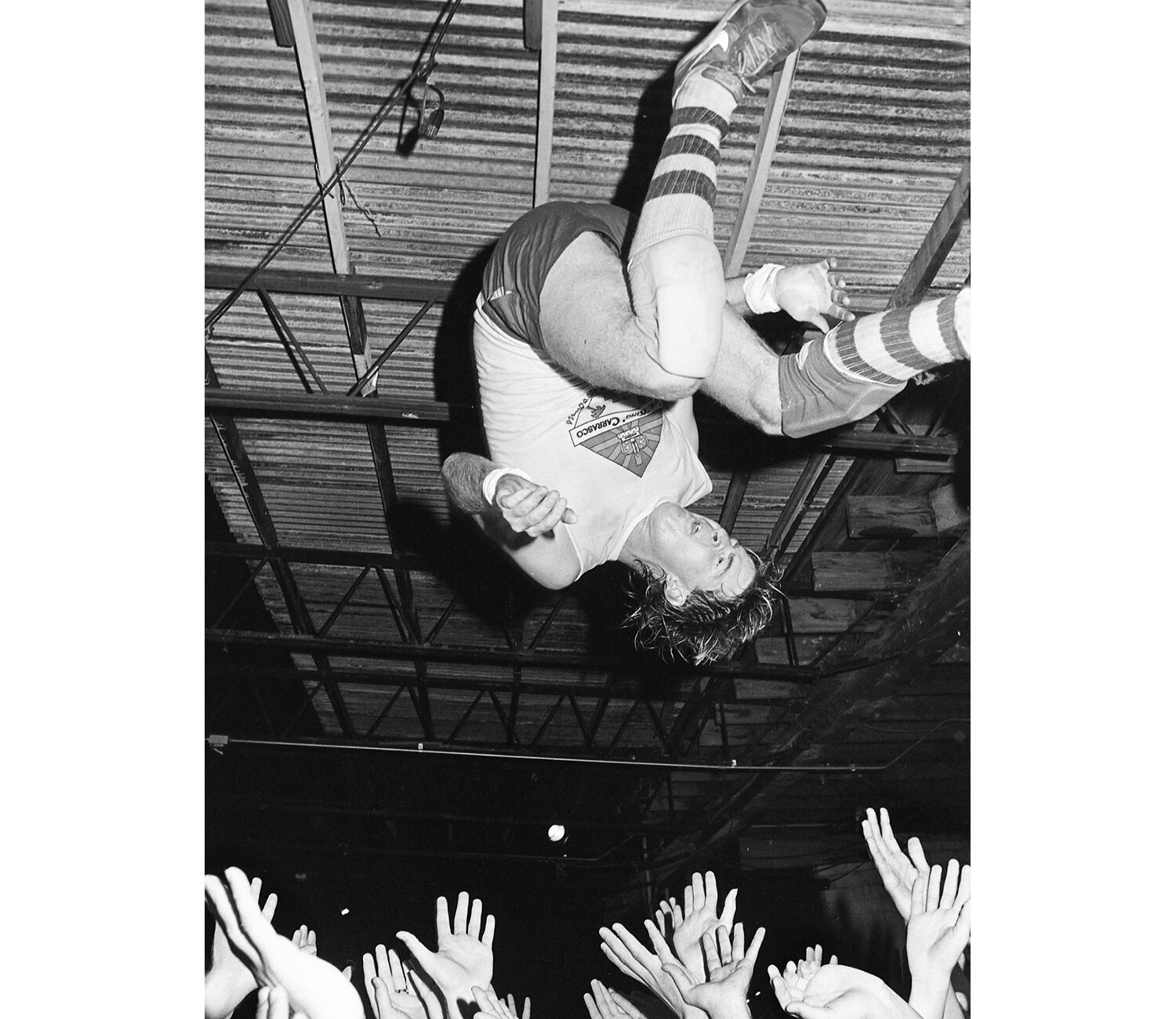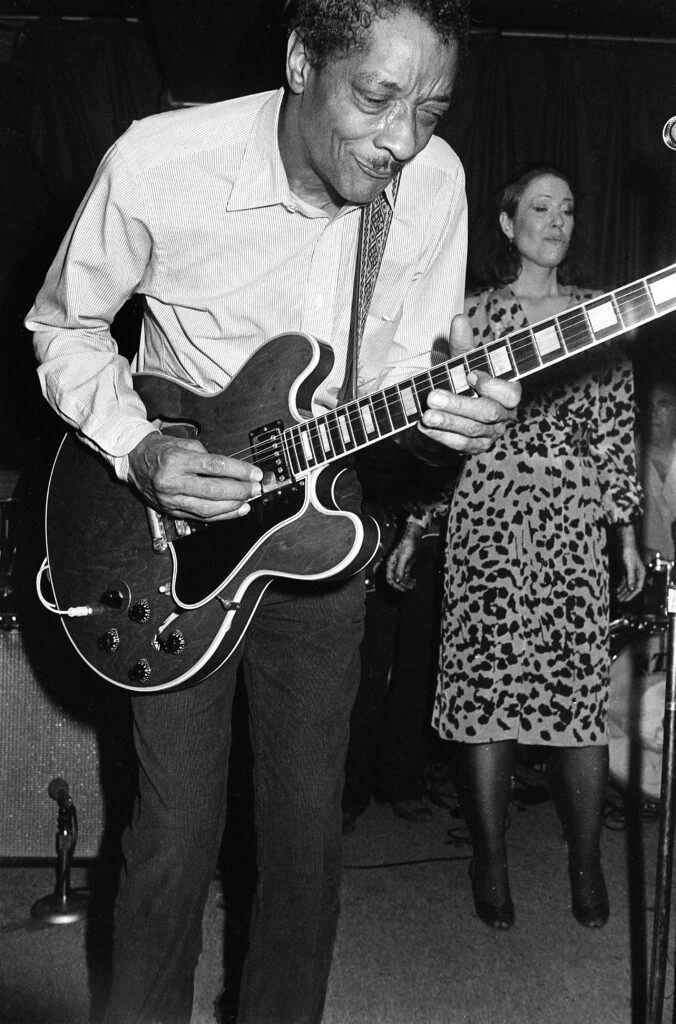It’s Friday night. You put down your textbook, pack your notes into your backpack, and head out to meet up with your friends. Perhaps you’ll suggest seeing Willie Nelson at his Opry House, The Talking Heads at the Armadillo, Run-DMC at the Liberty Lunch, R.E.M. at Club Foot, or maybe you’ll stay close to campus and catch a local punk band at Raul’s. Or, if you’re in the mood for something quieter, you might want to browse for a new record — there’s always Inner Sanctum Records or Waterloo Records. And as you walk down the Drag, maybe you’ll run into Daniel Johnston trying to sell you one of his homemade tapes.
If you were a student at UT Austin between 1980 and 1985, chances are you spent your time soaking up the city’s vibrant music scene. Austin always had a strong connection to music, but when it was officially named the “live music capital of the world” in 1991, it wasn’t just a marketing gimmick – the city had a genuine claim to the title, thanks in part to its often-overlooked music scene in the 1980s.
In the 1960s and 1970s, Austin musicians became national superstars, and with their rising popularity came plenty of attention and secondhand glamour for the capital city. “Austin’s reputation in the early to mid-’80s was premised on the international stardom of Willie Nelson and the ascent of Stevie Ray Vaughn,” says Jason Mellard, assistant director for the Center for Texas Music History at Texas State University. But the bright spotlight was also becoming more of a ubiquitous glow as most of Austin’s musicians flourished off-radar across the city. The 1960s and ‘70s may have laid claim to Austin’s golden era in terms of its nationally recognized artists, but it was during this transitional period in the 1980s that different musical styles increasingly branched out across the city, with live music on seemingly every street.
At the turn of the decade, popular and alternative music was heading in new and exciting directions. Hip-hop was in its infancy. Punk had arrived, supposedly died, and inspired a plethora of DIYinfused styles of rock music, including the hard-to-define “new wave.” Disco and funk-filled dance floors proliferated, and mainstream rock bands were beginning to fill ever-larger stadiums. Meanwhile college towns, with their affiliated radio stations and student populations eager to see the freshest new bands, fed a growing demand for American alternative music.
Austin in the early 1980s was exceptional even among college towns, even with the loss of the Armadillo World Headquarters, an incubator for Austin’s renowned country and rock scene in the 1970s that closed its doors in 1980. Want new wave? You could head to the corner of Brazos and 4th to the two-story, partially underground warehouse named Club Foot. If you were a punk? Raul’s at the top of the Drag was everything you could hope for in a dark, grungy dive bar. Or, for a bit of everything, there was the packed dance floor at Liberty Lunch, the former lumber yard on West 2nd which, in 1981, used the steel beams of the Armadillo World Headquarters for its newly built roof.
Alternatively, if you didn’t want to stray away from campus, you could catch a more intimate show at the Cactus Cafe or at the Union ballroom. Opened in the Union in 1979 and a consistent student favorite ever since, the Cactus Cafe hosted touring bands and university-affiliated musicians alike. Together with Raul’s and Hole in the Wall on the Drag, the Cactus Cafe and the Union ballroom were fundamental to the university’s influence on Austin’s music scene in the early ‘80s. Some of that influence could be seen in the bands students formed on and off campus. “We’re very UT-oriented,” Brown Cathell, lead vocalist of The Argyles, told the Cactus yearbook in 1984. “The very first thing we ever did together was a talent show in the Union.” The Argyles placed second in the talent show at the Union, as did rock band The Wait the year prior. In addition to the talent shows, both bands gained further exposure by playing at fraternity parties across campus.
“UT’s student body was seen for most of this period as foundational for live music audiences,” Mellard says. “The draw Austin held for Texas’s wayward youth had everything to do with UT as a critical mass of young folks.” For many students, Austin’s venues formed a fundamental and formative part of their college years, whether they were dancing at their fraternity houses, in dark campus dive bars, or wearing shorts and casual shoes in open-air arenas. When asked what they remember most about their time at UT in the early ‘80s, alumni mention the music again and again.
“It was just easy,” says alumna Linda Neavel Dickens. “Imagine being in your 20s and maybe it costs $3 to go hear somebody, maybe $5. It made it a lot easier just to go out and have fun. A lot of the music was outside also, which was wonderful. You’d show up in tennis shoes and shorts and t-shirts because you knew you were going to be just dancing like crazy.”
Zelda Shute, another 1984 graduate, recalls how affordable it was to go to a show in the early 1980s, meaning “live music was available to anyone.” “Everything was much more relaxed,” agrees alumna Maureen Taft. “1984 in Austin was a blast — going to so many concerts.”
The bands coming out of the local scene were as dynamic as the venues themselves. Central to Austin’s emerging claim to be the live music capital was the variety and experimentation of its musicians. It didn’t go unnoticed. “The Austin music scene is incredibly rich and varied,” The Daily Texan wrote in January 1981. Students could experience one of the most trailblazing hardcore scenes in the country, with Big Boys’ often anthemic and funk-infused singalongs and Dicks’s sharp polemics, which could comfortably belong in the 2020s as much as they did in the early ‘80s. Joe “King” Carrasco similarly wowed Austin crowds with his brand of “Tex-Mex Rock ‘n’ Roll,” finding inspiration in Mexican music as well as the eccentric experimentation of new wave. Even in alternative country, a genre that Austin was famed for in the 1960s and ‘70s, bands like Asleep at the Wheel, Joe Ely, Timbuk3, and Two Nice Girls were all experimenting with the conventions of the genre in unique ways.
Alongside these up-and-comers, established acts were also a common feature in ‘80s Austin — often taking the stage at the Frank Erwin Center, the imperious “superdrum” that could hold up to 18,000 rapturous fans on any given night. In 1984 alone the Erwin Center saw Bruce Springsteen, Elton John, The Bangles, Cyndi Lauper, The Beach Boys, Chicago, Van Halen, Kool & the Gang, Duran Duran, and Genesis, with Madonna, U2, Toto, Beastie Boys, Diana Ross, Bon Jovi, Tom Petty and the Heartbreakers, Kenny Rogers, AC/DC, Dolly Parton, Prince, and Kiss following up in 1985. When the Talking Heads played in Austin in November 1980, the Austin American-Statesman published a glowing review, calling it “a grand evening,” even if, “it was all too short…and for ten dollars.” When asked what one thing about living in Austin in the early 1980s he could bring back, UT alumnus John Adamo replied, “I would like to see the Talking Heads get back together for one more tour.” If they could somehow keep the tickets at early ‘80s prices, Adamo would hardly be alone.
In the emerging age of the music video, Austin also featured in one of the biggest hits of the 1980s. You can see remnants of local landmarks present and past in the music video for The Clash’s song “Rock the Casbah,” filmed in Austin, featuring the band riding in a Cadillac down I-35 facing the Austin skyline and performing in front of an oil rig in Bastrop as well as shots of a jet flyover near Bergstrom Airforce Base and an armadillo running through every scene.
It is no coincidence that the “live music capital of the world” tag emerged during this period, first in the Austin Convention Center and Visitors Council’s 1985 ad in Billboard and then officially adopted by the City Council as a tourist slogan in 1991. Local political bodies realized that the city’s rich cultural heritage was its defining feature. While music had always been a key feature of the city, the title would not have held the same weight without the immediate impact of Austin’s ‘80s music scene.
Austin’s growing underground scene also caught the attention of one of the most notable arbiters of cultural taste of the era: MTV. In an edition of the network’s The Cutting Edge in July 1985, the show spotlighted Austin’s music scene, featuring brief (and often awkward) interviews with musicians, live performances, and interludes of poetry. It was a snapshot of an eclectic and vibrant music scene amid the city’s transition from a relatively quiet university town in the heart of Texas to a bustling city. “Through it all,” The Cutting Edge concluded, “the bands survive. Playing parties, outdoors, and sometimes in real garages.”
Eddie Watson is a graduate of UT Austin’s history doctoral program. His research focuses on youth culture, DIY music, and working-class communities.

